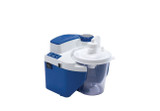Respiratory Medical Supplies
Respiratory therapy medical supplies include oxygen concentrators, nebulizers and nebulizer parts, tracheostomy supplies, and oxygen supplies. Express Medical Supply has a wide selection of medical supplies to treat respiratory conditions at home. Respiratory care products are tools that clear a congested airway or administer medication to those who cannot breathe independently. Conditions like asthma and COPD may require the use of respiratory devices like a nebulizer, which delivers medication in the form of a vapor. Aspirators, also known as suction machines, clear the airway of any fluid that can restrict breathing. Those with sleep apnea may use a CPAP device, which delivers a pressurized stream of oxygen so the airway doesn't collapse during inhalation. Express Medical Supply also carries the supplies you need to continually use your breathing equipment, such as filters and tubing.
Many people who have asthma use a device such as the DeVilbiss Nebulizer to help facilitate breathing. Liquid medicine goes into the nebulizer unit, which then turns the medication into a mist. The mist then flows through clear vinyl tubing and is inhaled by the patient. Our portable nebulizers are lightweight, making them easy to use both at home and during travel. We also carry handheld nebulizers that are small and ideal to use as a backup for your regular nebulizer.
To keep your nebulizer performing properly and extend its life, it should be cleaned regularly. Taking steps such as changing filters and cleaning reusable masks will help you get the most out of your machine. Although various components of the machine can be cleaned, the tubing should be disposed of periodically rather than washed and reused. Please see our blog for instructions on how to clean your nebulizer.
Many respiratory conditions can cause a build-up of fluid in the lungs and airway that is hard to expel. Being unable to clear your airway independently causes difficulty breathing. A suction machine, such as the Schuco Suction Pump, is used to remove fluids from the air passage. A suction machine creates negative pressure to draw fluids out of the airway and through tubing that connects to a collection canister. The machine also incorporates filters to contain bacteria within the collection bottle. It is important to regularly replace filters and clean the bottle after each use. Portable suction machines can make travel easier. They are also a great product to have in case of power outages since they can run on battery backups.





























